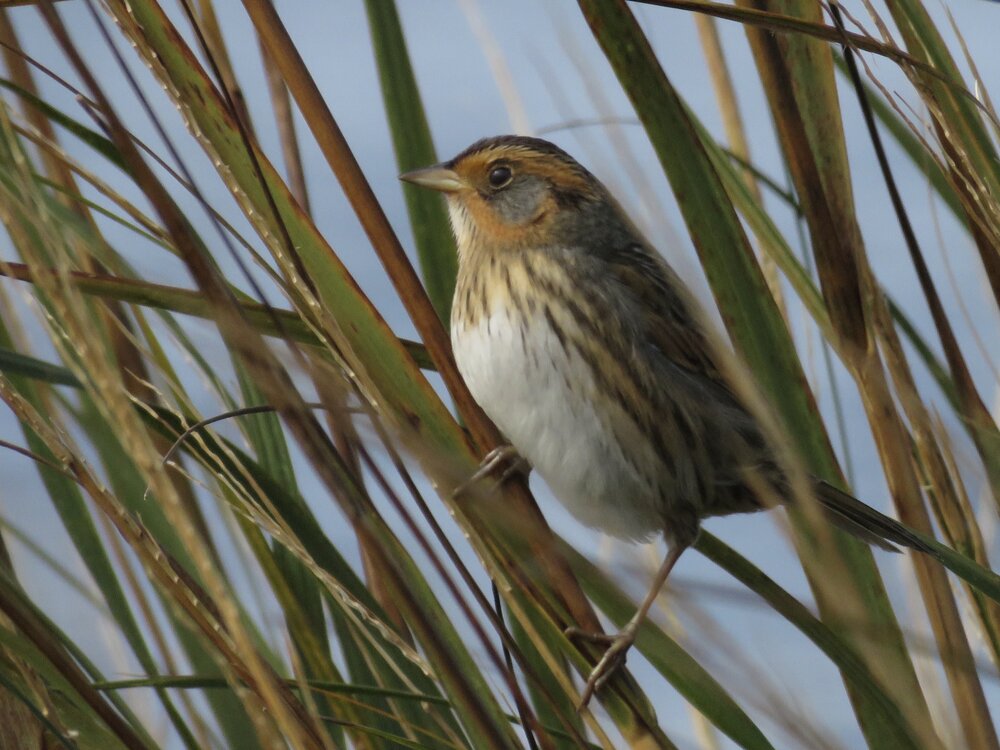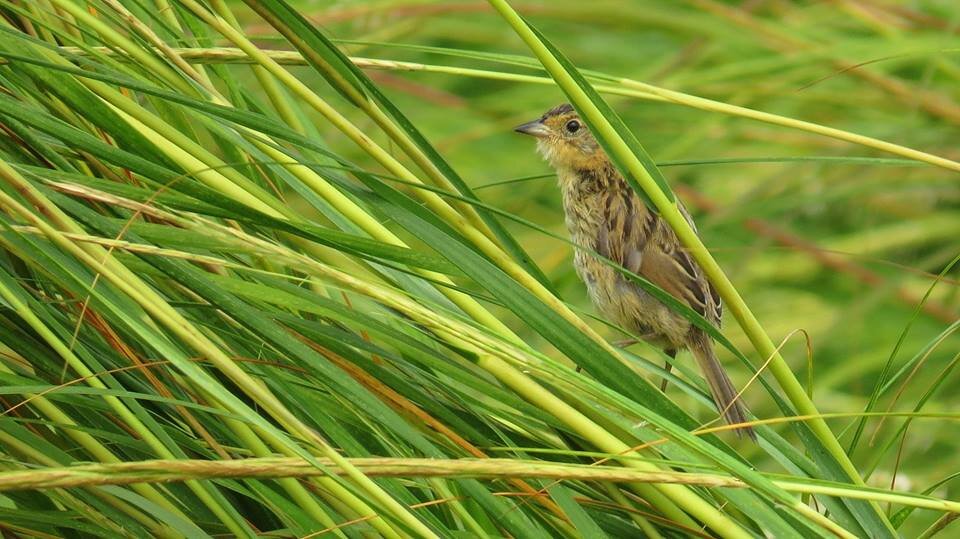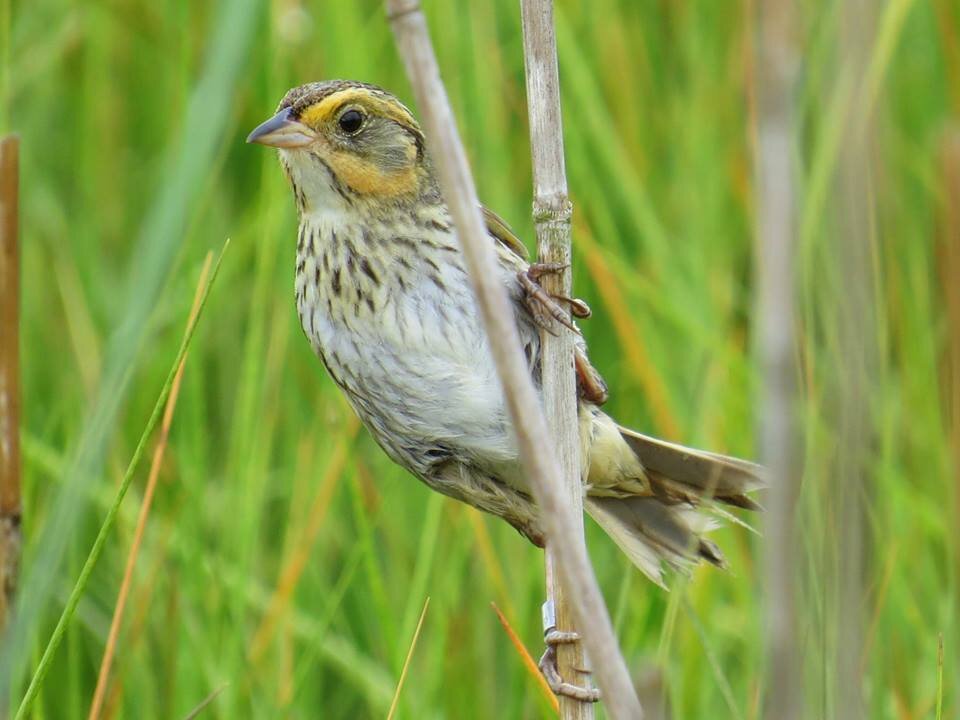Why the salt marsh sparrow is going extinct, and how rising seas and climate change are sealing its fate.

The salt marsh sparrow, a song bird found in coastal marshes from Maine to Virginia, is losing about 9% of its population each year. Sea level rise and a transforming environment are predicted to seal the bird’s grim fate. The sparrow is projected to join the likes of the dodo bird and passenger pigeon within the next 51 years. Photo courtesy of Patrick Comins, Executive Director, The Connecticut Audubon Society.
As sea levels continue to rise, conservationists work hard to ensure the future of Connecticut’s 98-plus miles of coastal marshes.
Connecticut’s coastal marshes help protect communities from ravaging storms and battering waves, and many species, including the salt marsh sparrow, call them home.
To safeguard marshes Sacred Heart University has positioned large Swiss-cheese-like concrete balls in front of a section of a marsh at Stratford Point, where Audubon Connecticut now manages them. Scientists call them reef balls, and they reduce the impact of slapping waves.
A scientist who helps manage the site says salt marshes and their inhabitants are better off thanks to the hollow concrete orbs.
Above: The reef balls at Stratford Point in 2014 compared to 2017. Over the three-year course there’s a noticeable increase in reef balls. In 2017, the marsh behind the balls appears to be more lush.
“There’s some hope for salt marshes, and salt marsh sparrows. Instead of killing a marsh, we actually grew one,” said Genevieve Nuttall, conservation programs associate at Audubon Connecticut.

A conservation project started by Sacred Heart University and managed by Audubon Connecticut involves concrete spheres called reef balls in front of a portion of the marsh at Stratford Point to protect it. Photo courtesy of Genevieve Nuttall.
Reef balls provide moderate optimism for Nuttall, but the researcher leading the charge on salt marsh sparrow research says current conservation projects may not be enough for salt marsh sparrows that nest in these salt marshes.
“It’s positive that people are starting to pay even a little bit of attention and try to experiment, but given that these birds have as little as 20 years, not 50 or 60 years, it’s just not clear we can solve the problem fast enough to be able to prevent the extinction,” said Dr. Chris Elphick, an ornithologist at the University of Connecticut.
Due to more frequent nest flooding the salt marsh sparrow, which nests exclusively in salt marshes on the Atlantic coastline from Maine to Virginia, is predicted to join the likes of the dodo bird and passenger pigeon within the next 51 years.
The Cornell Lab of Ornithology currently lists the sparrow as a priority bird, and sea level rise fueled by climate change is drowning it out of existence.
>
“Our model suggests somewhere around the middle of this century we expect this species to go extinct,” said Elphick, “It could be as early as the 2030s, or it could be as late as the 2060s. ”
Population Decline
Elphick says that if we started 20 years ago, maybe the outlook for salt marsh sparrows would be better.
His data projects somewhere between the 2030s and 2060s the point of no return will be reached, meaning that nest flooding will occur every two weeks. Two weeks is too frequent for the nests and their delicate contents. Though this critical point hasn’t been reached yet, scientists are seeing the destruction taking place.
A former student of Elphick’s has witnessed the population decline.
“I’ve worked on marshes where in 2007 I could go out and capture 50 salt marsh sparrows in a day very easily,” said Jennifer Walsh, a researcher with the Cornell Lab of Ornithology. “I’d return to the same marshes in 2015-2016 and maybe see four birds on the whole marsh.”
Populations are dying fast.
Elphick says 75% of the global population of salt marsh sparrows has disappeared since the 1990s. That’s roughly 9% of the population dying every year.
“If you can assume that the rate of decline continues, that suggests that the species is on a very rapid trajectory towards extinction,” said Elphick.
Nesting
Sea level rise is making it difficult for the species to nest successfully.
Their nesting territory is in the high marsh and they build their nests right above the high tide line in the grass. Walsh says looking down into the opening of her 12-ounce coffee cup reminds her of looking into a sparrow’s nest.
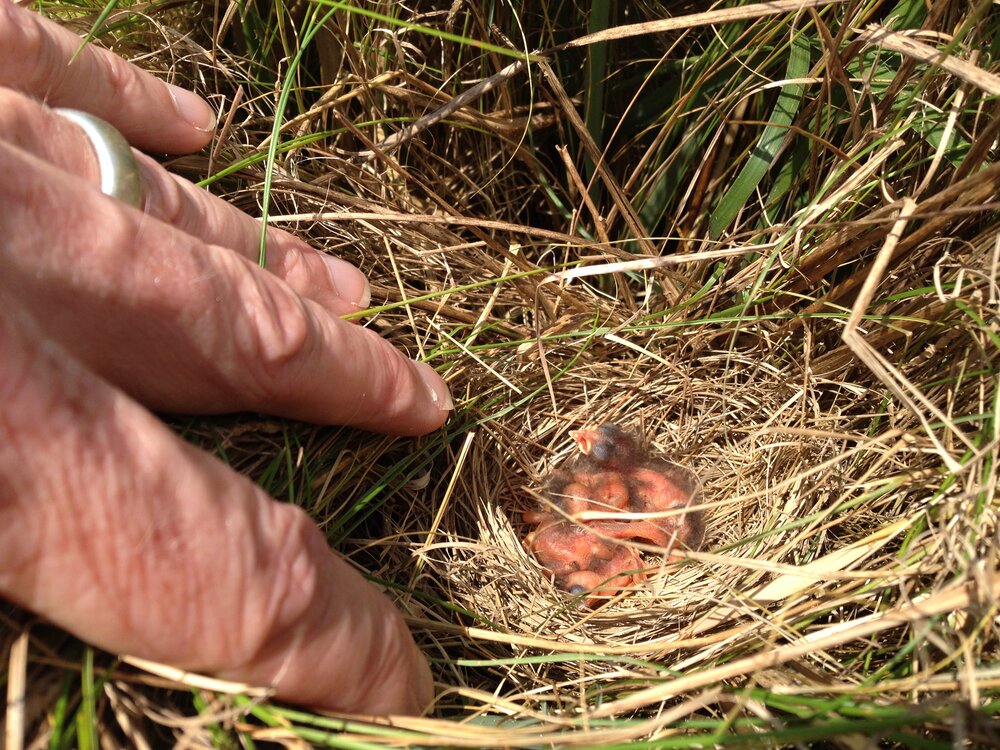
The rapidly disappearing salt marsh sparrow nests in the tall grasses of coastal salt marshes. Walsh says looking down into the opening of her 12-ounce coffee cup reminds her of looking into a sparrow’s nest. Elphick says the sparrow is a unique songbird because the fathers are promiscuous, and nests often contain eggs from multiple fathers. Unlike other song birds, the fathers do not protect the nesting territory. Photo courtesy of the U.S. Fish and Wildlife Service.
High marsh areas are used to flooding occurring about every 28 days.
“Salt marsh sparrows have a nesting cycle that’s about 26-27 days long,” said Walsh.
But tides are getting too high.
“Historically this (26-27 days) has been enough to get them through these high tides, but tides are getting higher due to sea level rise, and we’re having these more unpredictable storms, and the frequency and duration of storms is cutting into their nesting cycle and making it harder for them to fledge offspring.”
Where the species is adapted to living is no longer safe.
“Basically the places that are safe within these marshes that these birds have evolved to be able to use are becoming less and less safe even though they are specialized and are able to identify these good spots, these spots are getting worse, and worse, and worse,” said Elphick.
The tides are changing too fast.
>
“If they had thousands of years to evolve new habitat selection behaviors, then they could probably handle the changes, but these changes are happening too fast. The population is already so small that the likelihood they could evolve to those changes on a reasonable timeline is very, very, very low.”
Photos courtesy of Patrick Comins.
Rising Water
Sea level rise shows no signs of stopping.
Data from NASA shows sea levels rising at 3.3 millimeters a year. If rise continues at this rate, then 100 years from now water levels will be over a foot higher, and this will mean more devastating high tides. Levels a foot higher are impactful for coastal locations like Miami, New York City, Bridgeport and New Haven.
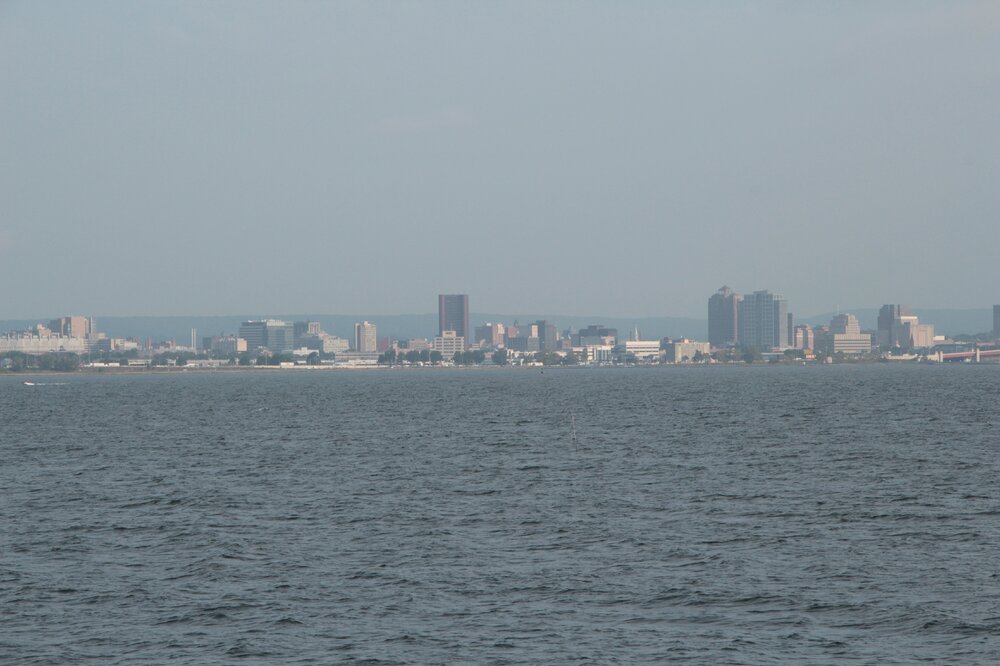
The city of New Haven is one of the cities in Connecticut that’s expected to be affected by sea level rise. Nasa data suggests rise at 3.3 millimeters a year. In 100 years a foot of water will be encroaching on New Haven and coastal cities across the globe.
Connecticut’s communities are already taking on water.
“All of our coastal towns, not only in this state, but across the Atlantic seaboard are realizing that the sea is rising, their infrastructure is getting flooded on a much more constant manner, and during high tides a lot of roads are underwater where 20 years ago they weren’t,” said Min Huang, a migratory bird program leader at the Connecticut Department of Energy & Environmental Protection.
Sea level rise is flooding towns, diminishing salt marshes, and expected to cost Connecticut a pretty penny.
According to SeaLevelRise.org, “There are already over 7,000 properties at risk from frequent tidal flooding in Connecticut. The state is planning over $2 billion in sea level rise solutions, which include restoration projects, catastrophic flood prevention, and building seawalls.”
With sea level rise, coastal wetlands across Connecticut and the U.S. are disappearing.
According to the U.S. Fish and Wildlife service, more than half of all of America’s wetlands have been lost since the 1780s. Connecticut is one of ten states that has lost over 70% of its wetland acreage since the 1780s.
If Connecticut and other areas lose their coastal marshes, they lose the benefits that come with them.
The Value of Marshes
With dwindling wetlands Walsh says we lose important biodiversity and natural storm barriers.
“I think preserving salt marsh habitats should speak to everyone because salt marshes provide barriers from coastal storms, and it’s been shown that places with active and healthy salt marsh ecosystems have saved millions, and millions of dollars,” said Walsh.
Research suggests she’s right.
“We estimate that coastal wetlands saved more than US $625 million in avoided flood damages from Hurricane Sandy across the northeastern USA,” wrote Siddharth Narayan and others in a 2016 report, “Coastal Wetlands and Damage Reduction.”
Lost coastal marshes means communities inland lose a natural barrier from clobbering storms and thumping waves.
“If you think of salt marshes as a buffer, the storm will hit the marsh instead of the house, which will help prevent an insurance crisis,” said Nuttall.
On top of that, Nuttall says marshes are responsible for absorbing and storing greenhouse gases.
Less marshland results in less protection, and storms hit local communities harder, causing millions more in damage.
Mass Extinction
We’re not just losing marshes though. According to scientists, fading coastal wetlands, and the extinction of the salt marsh sparrow are emblematic of a larger issue: climate change and the degradation of Earth’s ecosystems.
Elphick says the salt marsh sparrow is the proverbial “canary in the coal mine.”
“Humans are decimating wildlife habitats across the globe right now and whether people want to believe it or not, we’re going through the greatest mass extinction in human history,” said Huang of the Connecticut Department of Energy & Environmental Protection.
There have been a number of mass extinction events throughout geological time. Elphick says that since humans have been on the earth, we’re now facing the fastest rate of extinction across species since the death of the dinosaurs.
“The current number of species that have been lost is nothing like as severe as those previous mass extinctions, but the rate at which species are starting to go extinct, or predicted to go extinct in the next century or so is equivalent to during those mass extinction events,” said Elphick.
This has big implications for humans.
>
“If the animals can’t live here, then ultimately the humans won’t be able to live here either. Again, humans are really just animals as well.”
Current climate change and extinction trends boil down to toxic human activities.
“The fundamental problem is that we’re very massively changing the climate on the planet, and if we don’t get serious about doing something, then it will not just affect the sparrow, it’s going to affect hundreds of different species of birds and other things, as well as having very serious repercussions for people,” said Elphick.
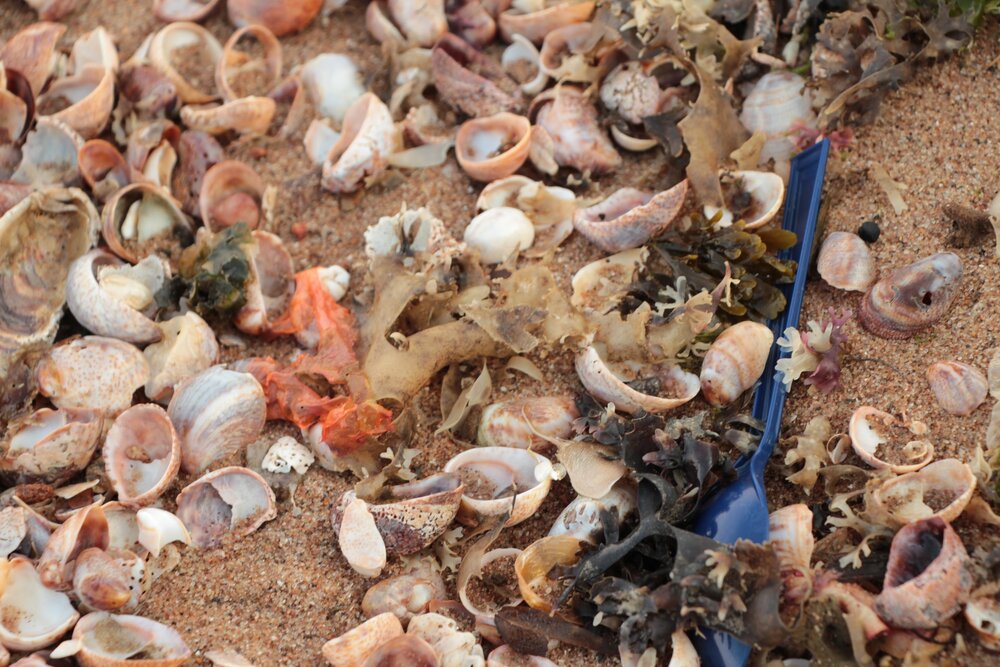
A plastic spoon among seashells and seaweed on a beach at Lighthouse Point Park, New Haven, Connecticut. Humans are changing the natural environment by putting things into it that are not meant to be there. A couple examples are trash, and gaseous emissions.
Where Humans Fit In
Scientists agree, humans are destroying the environment. The things is that humans have the ability to change this. Elphick says the the planet hasn’t reached the point of no return yet, but it will if people don’t take action.
Scientists say if you want to help, reduce your individual carbon footprint, get involved in your community, and vote for politicians that prioritize the environment. To preserve marsh life, a video by Coastal Resilience says to ask your congress members to support natural and coastal infrastructure projects, and to support the expansion of the Coastal Barrier Resources Act.

Humans play a major role in helping fight against climate change and destruction of the environment. Actions such as reducing individual carbon output can help in combating climate change. Made with Pablo.
Researchers say the sparrow likely can’t be saved.
“A single species like a sparrow is not terribly important,” said Elphick, “The trouble is we’re taking this attitude with hundreds of species, if not millions of species. That continuous erosion of biodiversity does have repercussions on how the ecosystem works, and it impoverishes the variety of life on the planet, and has aesthetic, ethical, as well as economic consequences for us.”
Humans are degrading the environment, and wiping species off the face of the earth. People alive and soon to be alive will no longer be able to see some of the precious wildlife that exists now.
>
“One way to think about it is if you took one Van Gogh and burned it, would that really change anyone’s life? Probably not, but it would be one less bit of beauty in the world and one less thing of interest in the world.”
